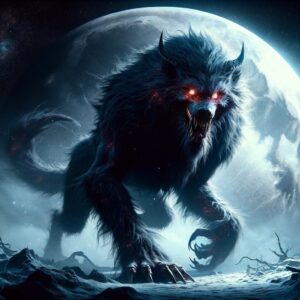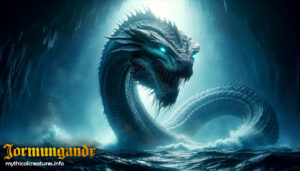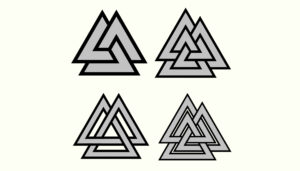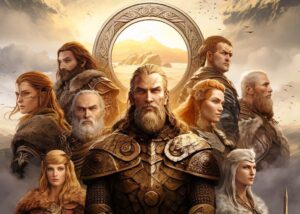Table of Contents
Hati is a wolf-like being with a rich history and a significant role in the stories of the cosmos.
Origins
Hati’s origins are deeply rooted in the ancient beliefs of the Vikings and the broader Germanic peoples. Norse mythology, the source of Hati’s existence, is a multifaceted and intricate system of beliefs and stories that shaped the spiritual worldview of these cultures. Here’s a more detailed exploration of its origins:
Norse mythology emerged from the pre-Christian religious beliefs of the Germanic tribes inhabiting Northern Europe, including regions that are now part of modern-day Scandinavia, Germany, and the British Isles. Generations passed down these beliefs orally before they gradually transitioned into written form during the Viking Age and in subsequent medieval sources.
Hati’s presence in Norse mythology reflects the people’s deep connection to the natural world, celestial events, and their understanding of the cyclical nature of time. It’s a testament to how ancient cultures sought to explain the mysteries of the cosmos through storytelling and mythological symbolism.
Family
Hati’s family ties provide further insight into its place within the larger context of Norse mythology. Here’s a more detailed look at its family:
Hróðvitnir, the Father: Hróðvitnir, the father of Hati, is a wolf-like creature himself. His name, “Hróðvitnir,” can be roughly translated to “Fame-Wolf” or “Fame-Tester.” This name suggests a creature of great renown or significance in the mythology.
Sköll, the Sibling: Hati’s sibling, Sköll, shares celestial associations but is linked to the sun rather than the moon. Just as Hati relentlessly pursues the moon, Sköll chases the sun across the sky. The duality of their roles symbolizes the balance between light and darkness, day and night in the cosmos.
Appearance

Hati is a creature of monstrous proportions, standing out even among the fearsome creatures of Norse mythology. Its appearance is designed to instill fear and emphasize its role as a harbinger of doom. Here are more detailed descriptions of its physical features:
Immense Size: Hati is often described as being of colossal size, dwarfing ordinary wolves. Its sheer size is enough to make it a formidable presence, and it commands attention wherever it roams.
Fur as Dark as Night: Hati’s fur is a deep, abyssal black, like the darkest of nights. This coloration serves to make the creature nearly invisible in the darkness, allowing it to move stealthily through the night sky as it pursues the moon. The inky blackness of its fur represents the forces of chaos and darkness.
Otherworldly Eyes: Hati’s eyes are perhaps its most striking feature. They burn with an eerie, otherworldly intensity, radiating an unsettling, crimson or fiery glow. These fiery eyes are said to reflect the creature’s insatiable hunger and its relentless pursuit of the moon. The intensity of its gaze is a chilling reminder of the cosmic forces at play.
Menacing Demeanor: Hati’s overall demeanor is menacing and foreboding. Its posture frequently appears hunched, signifying readiness to pounce at any moment. Its sharp, gleaming teeth remain visible even when its mouth is closed, creating a perpetual snarl. Its robust limbs are purpose-built for speed and agility, enabling relentless pursuit of the moon without rest.
Shadowy Aura: Depictions of Hati frequently include an almost shadowy aura, reinforcing its connection to the darkness and chaos it symbolizes. This aura seems to shroud the creature, making it appear as if it exists on the fringes of reality, just beyond the reach of mortal understanding.
Abilities
Hati possesses several remarkable abilities, which add to its mystique and importance in Norse mythology:
Celestial Pursuit: Hati earns its reputation for relentlessly pursuing the moon. Norse mythology holds that Hati and its sibling, Sköll, chase celestial bodies across the sky. Hati’s target is the moon, while Sköll chases the sun. This celestial pursuit symbolizes the cyclical nature of time and the cosmic order in Norse belief.
Inexhaustible Stamina: Hati’s stamina is legendary. It can chase the moon night after night without tiring. This tirelessness represents the eternal forces of darkness and chaos that the creature embodies.
Connection to Ragnarök: Hati’s significance becomes most apparent in the context of Ragnarök, the Norse apocalypse. It is prophesied that during Ragnarök, Hati will finally catch and devour the moon, plunging the world into darkness and chaos. This event marks the beginning of the end, as it signifies the start of the cosmic upheaval that will ultimately lead to the world’s destruction.
Weaknesses

Despite its fearsome reputation and incredible abilities, Hati is not without vulnerabilities. In Norse mythology, the inevitability of its actions, leading to Ragnarök, can be seen as a kind of fatal flaw. It is bound by destiny and cannot deviate from its role in the cosmic order, making it a prisoner of fate.
Symbols Representing Hati
Hati doesn’t frequently feature specific symbols like many other mythical creatures. Instead, it derives its symbolism from the celestial events it associates with—the relentless chase of the moon and the looming threat of Ragnarök. These events symbolize the cyclical nature of time, the inevitability of fate, and the ever-present forces of darkness in the world.
Related Myths and Stories
Hati’s Celestial Chase
In the ancient realm of Norse mythology, a tale unfolds that transcends the boundaries of the earthly world. It is the story of Hati, the relentless celestial wolf, and his eternal pursuit of the moon.
As night descends and the moon graces the sky, Hati awakens from his shadowy slumber. With eyes aflame like burning embers, he charges through the celestial expanse, his massive form eclipsing the stars. The moon, a radiant pearl in the night, becomes his quarry.
Hati’s pursuit is unending, a cosmic chase that defies the very fabric of time. Night after night, he draws closer, his fiery gaze fixated on the lunar prize. With each stride, he inches closer to fulfilling his destiny, a destiny intertwined with the impending doom of Ragnarök.
But as the moon continues its celestial dance, Hati’s relentless hunger is an omen of the chaos and darkness that loom on the horizon. For in the grand tapestry of Norse mythology, Hati’s chase of the moon is but one thread, leading to the cataclysmic unraveling of the cosmos.
Ragnarök’s Unstoppable Tide
Ragnarök, the apocalyptic event of Norse mythology, casts a long shadow over the gods and mortals alike. At the heart of this cosmic upheaval stands Hati, the devourer of the moon, a harbinger of the end.
As the final age dawns, the world quakes with the footsteps of giants, and the skies are rent asunder by the clashing of gods and their monstrous adversaries. Amidst this tumultuous chaos, Hati’s pursuit of the moon reaches its zenith.
With a leap that shakes the very foundations of Yggdrasil, the world tree, Hati seizes the moon in his monstrous jaws. It devours the once radiant orb, now shrouded in darkness, plunging the world into an eternal night.
The symbolism is clear – Hati’s celestial chase signifies the irrevocable descent into chaos. The world is no longer in balance, and the fate of gods and mortals hangs in the balance. It is a time of reckoning, a testament to the inevitability of destiny and the inescapable tide of Ragnarök.
Twilight of the Gods

In the final act of the Norse mythological drama, the cosmos trembles under the weight of destiny. The gods, once mighty and unassailable, now face their ultimate reckoning. Hati’s role as the devourer of the moon reaches its devastating climax.
As Hati consumes the moon, it blankets the world in darkness, extinguishing even the stars themselves. The great wolf Hati, having fulfilled his cosmic duty, retreats into the shadows, his insatiable hunger sated. The end is nigh.
Odin, the Allfather, rides to the battlefield with his valiant sons, Thor and Vidar. Loki, the trickster, faces his own destiny, battling the Æsir as well as the monstrous wolf Fenrir, who also seeks to bring about the end of days.
The battle rages, and gods fall in the throes of the ultimate conflict. Flames consume the world, and the earth is swallowed by the sea. But even amidst this cataclysm, the memory of Hati’s relentless pursuit of the moon lingers, a haunting reminder of the cosmic forces that shape the fate of all.
In the twilight of the gods, the inevitable plays out. Ragnarök unfolds, and the world is reborn from the ashes, a testament to the cyclical nature of time and the enduring power of myth.
Other Creatures
Fenrir. Fenrir is a colossal wolf, often described as a monstrous and ferocious creature. Like Hati, Fenrir symbolizes chaos and destruction. Bound by chains, he awaits his destiny to break free during Ragnarök, unleashing havoc upon the world.
Sköll. Sköll is another wolf-like creature, similar in appearance to Hati. While Hati chases the moon, Sköll pursues the sun, representing the balance between light and darkness in Norse mythology.
FAQ
What is Hati's role in Norse mythology?
Hati is known for its relentless pursuit of the moon, symbolizing the cosmic events leading to Ragnarök, the end of the world.
What is Hati's appearance like?
Hati is depicted as a colossal wolf with dark fur, fiery eyes, and a menacing demeanor.
Is Hati related to any other creatures in Norse mythology?
Yes, Hati has a sibling named Sköll, another wolf associated with celestial events, but linked to the sun instead of the moon.
What symbolism is associated with Hati?
Hati symbolizes the cyclical nature of time, the inevitability of fate, and the ever-present forces of darkness in Norse mythology.
What is Hati's role in Ragnarök?
During Ragnarök, Hati catches and devours the moon, marking the beginning of the cosmic upheaval that leads to the world's destruction.




